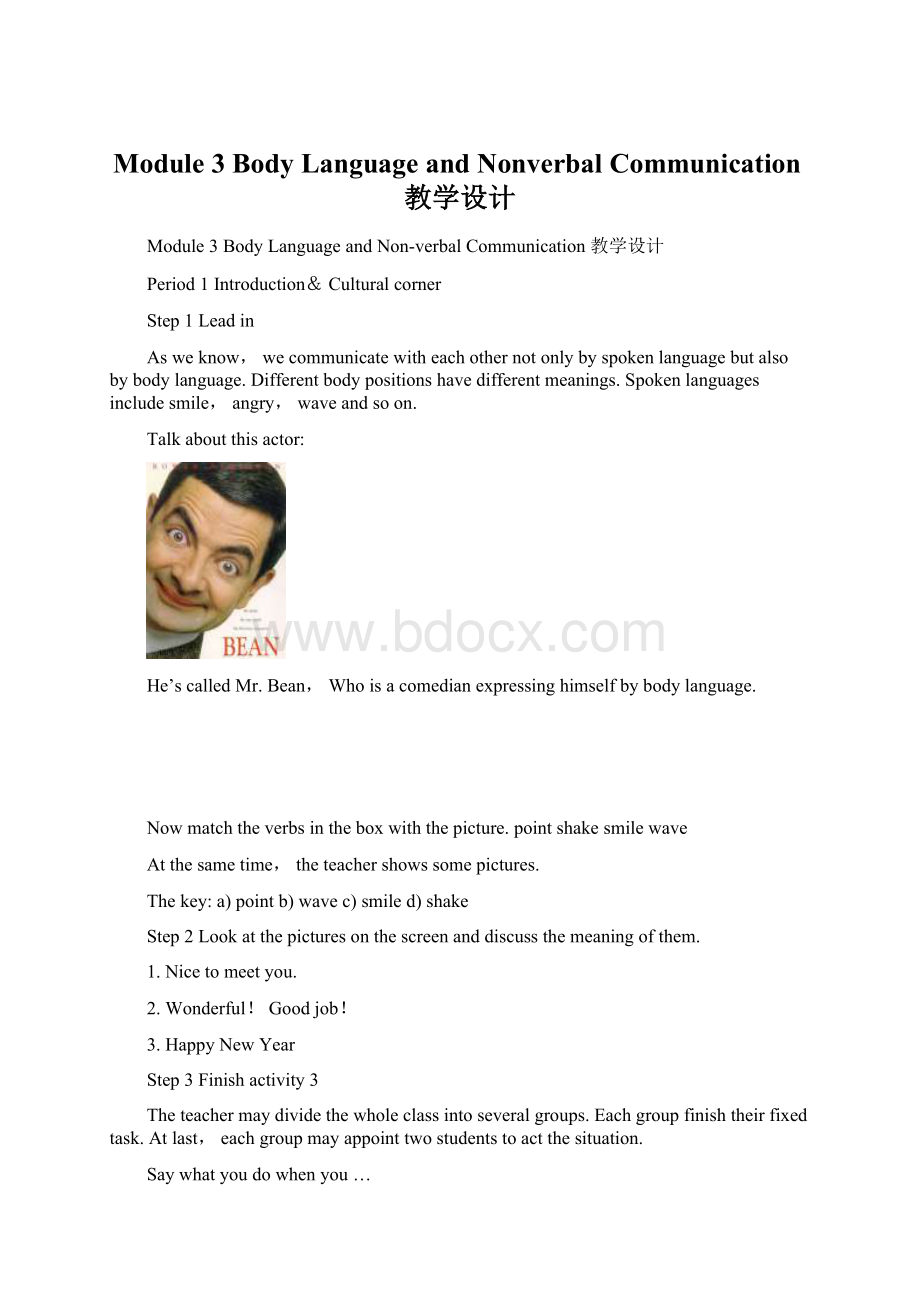Module 3 Body Language and Nonverbal Communication教学设计.docx
《Module 3 Body Language and Nonverbal Communication教学设计.docx》由会员分享,可在线阅读,更多相关《Module 3 Body Language and Nonverbal Communication教学设计.docx(11页珍藏版)》请在冰豆网上搜索。

Module3BodyLanguageandNonverbalCommunication教学设计
Module3BodyLanguageandNon-verbalCommunication教学设计
Period1Introduction&Culturalcorner
Step1Leadin
Asweknow,wecommunicatewitheachothernotonlybyspokenlanguagebutalsobybodylanguage.Differentbodypositionshavedifferentmeanings.Spokenlanguagesincludesmile,angry,waveandsoon.
Talkaboutthisactor:
He’scalledMr.Bean,Whoisacomedianexpressinghimselfbybodylanguage.
Nowmatchtheverbsintheboxwiththepicture.pointshakesmilewave
Atthesametime,theteachershowssomepictures.
Thekey:
a)pointb)wavec)smiled)shake
Step2Lookatthepicturesonthescreenanddiscussthemeaningofthem.
1.Nicetomeetyou.
2.Wonderful!
Goodjob!
3.HappyNewYear
Step3Finishactivity3
Theteachermaydividethewholeclassintoseveralgroups.Eachgroupfinishtheirfixedtask.Atlast,eachgroupmayappointtwostudentstoactthesituation.
Saywhatyoudowhenyou…
Example:
areintroducedtosomeone.→Ishakehandsandsay,“Pleasedtomeetyou.”
1.meetafriend→Ishakehandsandsay,“Pleasedtomeetyou.”
2.showsomeonetheway.→Ipointinthedirectiontheymustgo.
3.seeafriendinthedistance→Iwavemyhand.
4.enterafriend’shouse.→Ishakehandsandsay,“Hello,pleasedtoseeyou.”
5.sayyes.→Inodmyheadupanddown.
6.sayno→Ishakemyheadfromsidetoside.
7.saywho?
Me?
→Ipointtomyselfandputonasurprisedexpression.
8.saygoodbye.→Ishakehandsandsay,”Goodbye.”
Step4Finishactivity4(freechoices)
Readandanswerthequestions.
1.Howmuchdoyoucommunicatewithyourbody?
A.NotatallB.NotmuchC.AlotD.PerhapsmorethanIthink.E.Perhapsmorethanwithwords.
2.Canyougivereasonsforyourchoice(s)?
CulturalCorner
Step1Presentation
Asweknow,applauseplaysanimportantroleininteractingbetweenapplauseandaudience.Doyouknowthecustomofclapping?
Whydopeopleclap?
Fromthispassage,wewillknowmoredetailsaboutthetext.
Step2Listening
Listenandfindouttheanswerstothefollowingquestions.
1)Whatisthepassageabout?
Thepassageisaboutthereasonwhyweclapandthehistoryofclapping,thefeaturesofapplause.
2)Whydopeopleclap?
Toshowthattheylikesomething.
3)Howmanycountriesarementionedinthepassages?
Threecountriesarementioned.
Step3IntensiveReading.
Para1
1)Whatisthemainideaofthefirstparagraph?
Thereasonswhyweclap.
2)Onwhatoccasiondopeopleclap?
Weclapattheendofaliveperformance,suchasaplay,oraconcert,tosaythankyoutotheperformers.
Para2Whatisthemainideaoftheparagraph?
Thecustomofclappinghasearlybeginnings.
1.WhatdidapplausemeaninclassicalAthens?
Applausemeantjudgmentandtalkingpart.
2.Whatdidtheprolongedclappinghelp?
Prolongedclappinghelpedaplaytowin.
Para3Whatisthedefinitionofapplause?
Applausewasasignofbeingpartofthecommunity,andofequalitybetweenactorsandaudience.
Whatarethefeaturesofclapping?
Clappingissocial,likelaughter,itisinfectious,andspreadveryquickly.
Dopeoplefromdifferentculturesclaponthesameoccasions?
No,someoccasionsonwhichpeopleclapchangefromonecountrytoanother.
Period2Reading
Step1presentation
Theteachershowsthestudentsapictureaboutbodylanguage.Atthesametime.Theteacherasks:
Whatwordscometoyouwhenseeingthepicture?
youthsgestureinformalhighfiveholduppalmspreadfingersslapthentheteachershowssomeotherquestionsandpicturestohelpthestudentsgetmoreinformationaboutbodylanguage.
Step2Listentothepassageagainandchoosethebesttitle.
1.Sayingitwithoutwords.
2.WheninRome,DoastheRomansDo
3.GreetingsAroundtheworld.
4.ReadMyMind.
Thekey:
thebesttitleofthepassageisthethirdone.
Step3Readthepassagecarefullyanddecidethefollowingtrue(T)orfalse(F)
•Notallbodylanguageisconscious.
•Europeansshakehandswiththeirlefthand.
•InAsia,peopletouchstrangerswhentheymeet.
•IntheUS“ahighfive”isawayofsayinghello.
•A“highfive”isaformalgesture.
•Bodylanguageislesscommunicativethanspokenorwrittenlanguage.
Key:
1.T2.F3F4T5F6F
Step4Letthestudentsreadthetextsquicklyandsilentlyandmatchthemainideawitheachparagraph
Para1greetingsinAsiancountries.
Para2waysofcommunications
ExamplesofgreetingsPara3fascinatingbodylanguages
Para4greetingsinwesterncountries
Para5Americanyouth’sgreetingstoday
Step5ExtensiveReading
Analyzethefirstparagraph.
Throughtwopicturesshowthesentencetothestudents“Greetingvaryfromculturefromculture.”Andthenfillintheblanks:
Wordsandsentencesspokenwords
Communicationswrittenwords
Bodylanguagebodypositions
unconsciousbodylanguage
learnedbodylanguage
Step6readthesecondparagraphanddecidewhetherthestatementsaretrue(T)orfalse(F)
•Unconsciousbodylanguageisusedwhenweareintroducedtostrangers()
(2)Wealwaysfeelrelaxedwhenmeetingstrangers.()
(3)Everyculturehasdevelopedaformalwaytogreetstrangers,toshowthemwearenotaggressive.()
(4)Europeansshakehandswiththeirlefthands.()
(5)Weshakehandswhenwemakeadeal.()
Thekey:
1.F2.F.3.T4.F5.T
Step7Analyzethethirdparagraph.Fillintheblank.
people
Howtheygreettraditionally
Chinese
Puttherighthandovertheleftandbowslightly.
Muslims
Touchtheirheart,mouthandforehead.(salaam)
Hindus
Jointheirhandsandbowtheirheadsinrespect.
Step8WordstudyActivity3onP23
Step9Accordingtothetextfillinblanks.
Step10Languagepoints
Step11Showthefacialexpressionsincludingangry,sad,painful,smile
Andleadthestudentstopayattentiontothelastone,that’ssmile,sothattheycangoontocarryoutfreetalk.
Step12Freetalk
Discuss.Dividetheclassintoseveralgroups.Andthenaskonestudentineachgrouptospeakouttheiropinions.
Smile,andtheworldsmileswithyou;weep,andyouweepalone.
Step13conclusion
你笑时全世界和你一块笑,你哭时只有你在独自哭泣.
Step14Homework.
Greetingsvaryfromculturetoculture.
Summarizethegreetingsindifferentcountriesaccordingtothepassage.
Period3ListeningandVocabulary
Step1theteachershowsapicturetothestudents.Andthenaskthemtotelltheirnamesofthepartsofthebody..
anklechesteyebrowfingerforeheadkneelipsshoulderwrist
Step2Lookatthelistofverbs.Completethesentences.
bendbowclaphugkissnodraisestarewipe
Step3ListentoaconversationbetweenanAmericanandaChinesestudentwhoisgoingtotheUS.
Numberthetopicsintheordertheytalkaboutthem.
______Whattotalkabout.______Gifts__________Whentoarrivefordinner
______Whattocallpeople_____Howtomeetnewpeople
______Whattosaytothehostwhenyouleave_____whentoleavethetable.
Nowworkinpairs.Checkyouranswers.
Thekey:
_1__Howtomeetnewpeople_2___Whattocallpeople___3___Gifts
__4___Whentoarrivefordinner___5___Whattotalkabout
___6__whentoleavethetable.___7___Whattosaytothehostwhenyouleave
Step4Listentotheconversationagainandfillintheblanks
Step5Matchthefollowingpiecesofadvicewiththetopicsinactivity3.
Step6Retelltheconversation
withthepictureshownonthescreen.
Step7Pronunciation
①ListentothisspeakerwithanAmericanaccent.
Listentothesespeakers.DotheyspeakinanAmerican(US)oraBritish(UK)accent?
Letthestudentsreadthroughthepassagestothemselves.
Playthetapeoncewhiletheyfollow.
Playthetapeagainforthemtodecide.Theycandiscusstheiranswerswithapartner.
Answers:
1)UK2)UK3)US
Period4Writing&EverydayEnglish&Function
Step1Readtheinvitationandanswerthequestions.
1.Whoisthefirstinvitationfrom?
2.Whoisthesecondinvitationfrom?
3.Whichisformalorinformation?
Howdoyouknow?
Mr.andMrs.HarryBlunkettrequestthepleasureofyourcompanyattheweddingoftheirdaughterElizabethAnnBlunketttoMr.Humphries,atStDavid’sChurch,LandrindodWellsonSaturdayMarch5that17:
00,followedbyadinnerdanceattheHotelMetropole.
BlacktieRSVP
Thesecondletter:
I’m16nextweek!
Pleasecometomyparty----greatfoodandevenbettermusic.
Date:
Saturday(March17th)
Time:
8tilllate
Place:
Myplace(ofcourse)
Sylvia
Thekey:
ØMr.&Mrs.HarryBlunkett
ØSylvia
ØThefirstinvitationisformal.Weknowbecauseofthelanguageused.
Step2Lookattheseexpressions.Whichareformal,andwhichareinformal?
PleasedtoacceptunabletoacceptThanksalotI’mverysorry
Thekey:
“Thanksalot”isinformal;theotherthreeareformal.
Step3Writeashortreplytooneoftheinvitations.Useoneoftheexpressionsfromactivity
2.ModelAnswer:
DearMr.andMrs.Blunkett,
Iwasdelightedtoreceivetheinvitationtoyourdaughter’sweddingonMarch5th.Iamverypleasedtoaccept,andlookforwardtomeetingyouthere.
Yourssincerely,
PeterJ.Smith
Step4EverydayEnglish
1)b2)a3)b4)a
Step5LookatthesentencesinListeningandVocabularyactivity4andcompletethesentencesbelowwithshouldormust.
Step6Workinpairs.Guessthecustomsbycompletingtheadvicewithshould,shouldn’tmustormustn’t.
Step7Theteachershowssomeothersentencespatterns.
1.Askingforadvice.
2.Advisingsomebodytodosomething.
3.Advisingsomebodynottodosomething
Period5Grammar
Step1Presentation
Step2拓展语法
我们知道,引导条件状语从句最常用的连词是if,由if